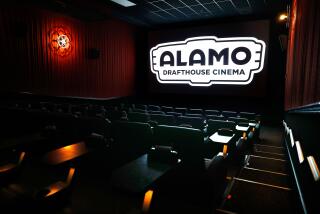Boeing Hopes Its Digital Cinema Technology Plan Will Fly
Boeing Co., which usually deals with airline executives and foreign governments interested in military aircraft, is about to place a huge bet on Hollywood.
And the Seattle-based company is doing so by injecting itself into one of the most contentious issues in the movie business: the conversion of the nation’s movie theaters to digital cinemas.
Boeing will unveil a plan Tuesday to finance the estimated $130,000-per-screen cost of the conversion via its leasing division, Boeing Capital Corp., which more typically funds the purchase of airliners.
Boeing officials say the offer will be made at ShoWest in Las Vegas, the largest annual convention of movie theater owners. They hope to sign up the first commercial customers for a digital transmission technology relying on satellites operated by El Segundo-based Boeing Satellite Systems.
Looking to expand beyond its core businesses into other potentially high-profit communications markets such as video on demand, Boeing first stepped into the digital cinema fray in November when it beamed the Ben Affleck-Gwyneth Paltrow movie “Bounce” to AMC’s Empire Theater in New York City. The company purchased the satellite unit from Hughes Electronics last year.
Boeing plans to wow exhibitors with the satellite delivery of Miramax/Dimension Films’ family action film “Spy Kids” into a casino ballroom at ShoWest.
But it won’t be the only company hawking digital technology and services to theater owners.
Technicolor and Qualcomm, which formed a joint venture to develop a digital transmission system for movies, are also expected to unveil a financischeme in which theater owners will pay a lease fee based on ticketed attendance at digital screenings.
Any positive response to these plans by theater owners at ShoWest would be particularly good news for Hollywood’s studios. As the distributors of movies, they hope digital projection will relieve them of the more than $800--million annual expense of striking prints of their films and shipping them to theaters around the country in metal canisters.
But interviews with theater operators, studio executives and technical experts suggest that digital cinema’s proponents may continue to find the format a tough sell among theater owners.
For one thing, the exhibitors and studios have failed to come to any agreement over sharing the cost of the transition.
“We’ve proposed to the studios coming together for comprehensive planning for the roll-out [of digital cinema],” said John Fithian, president of the National Assn. of Theater Owners, the exhibitors’ trade group. “To date, the studios have been unable to come together to talk collectively with us. This is seriously retarding the roll-out of digital cinema.”
Some people in both camps thought an industrywide discussion was imminent when Fithian and Jack Valenti, president of the Motion Picture Assn. of America, the studios’ trade group, announced at last year’s ShoWest that they agreed such talks should begin.
But they never happened, in part because of continuing doubts throughout the movie industry that the technology is ready to be commercialized.
“You can’t have digital cinema until the engineering standard is set,” Valenti said. That standard is still being worked on by the Society of Motion Picture and Television Engineers and other engineering standards bodies, with the support of MPAA and the theater owners’ group.
Valenti said he will leave it up to the individual studios, not his organization, to meet with theater companies to draw up a business strategy on digital cinema.
Fithian doesn’t buy the position that industrywide standards must be set before any serious business discussions take place.
“We think both have to happen simultaneously,” he said. “This is moving too fast not to have comprehensive planning.”
Talks, but No Deal
Some studio executives indicated that they have already begun to hold informal talks with theater owners, but nothing resembling any kind of financial arrangement is anywhere in sight.
“I’ve had conversations with almost every exhibitor as to what they’re feeling about digital,” said Dan Fellman, head of distribution at Warner Bros. He said Warner, which produced digital copies of such films as “A Perfect Storm” and “Space Cowboys” for pilot screenings, is “very interested in moving forward at a very fast pace, but we need to get a [joint] business plan moving.”
Among other issues, Fellman said, is assurance for the major theaters that enough theaters are equipped with digital projectors before they plunge into releasing movies in digital formats. And theater owners need to be confident that enough digital movies will be available to fill their halls.
“It’s one thing if there are 1,000 [digital cinemas] out there, but at the moment there are only 18 in the U.S.,” Fellman said. (There are about 15 more outside the U.S.) “If every studio’s Fourth of July movie is in digital but each one can only show on three screens, what’s the point?”
At the core of the economic dispute are diametrically opposed views of which side will benefit most from the new technology. The theater owners are afraid the studios will reap most of the financial benefits of the conversion and stick them with the bill.
That is a sensitive issue because 10 major cinema chains representing more than half the roughly 36,000 screens in America are operating under bankruptcy protection.
Studio executives contend the exhibitors are ignoring the chance to earn untold millions by using digitally equipped cinemas for “alternative programming,” including sports broadcasts and corporate events.
They also say the moviegoing experience must be vastly improved to compete with all the other demands on consumers’ leisure time, ranging from the Internet to DVDs.
Some studios, notably Walt Disney Co., have suggested that the impasse might be resolved only by third parties stepping in to provide transitional financing.
“The cost of conversion should be borne in proportion to the benefits received by distributors and exhibitors,” said Phil Barlow, executive vice president of Walt Disney Motion Picture Group. “While its easy to quantify the long-term savings for distributors, it’s harder to quantify the additional revenues that will come to theaters.”
Barlow believes the exhibitors are not as skeptical about the potential benefits from digital cinema as they claim to be. “Given the traditional relationship of suspicion between distributors [i.e., studios] and exhibitors, its obviously to the benefit of both sides to posture,” he said.
Compounding the economic dispute are real doubts that the technology of digital projection is genuinely ready for prime time.
Digital cinema means replacing the basic technology of 35-millimeter film projection--the beaming of light through a strip of celluloid spooling through a projector at 24 frames per second--with a system in which a stream of digital bits carries the information needed to illuminate the reflective screen at the front of the theater.
Improved Technology
Proponents of the new technology argue that it overcomes some of the enduring shortcomings of film projection. These include the subtle jitter of the image as it rolls through the projector and the progressive deterioration of the film with every showing because of its rough treatment by the projecting mechanism.
The digital image is not only sharper and clearer than film in many cases, but because it is not physically touched by the projector it remains as sharp on the thousandth viewing as on the first.
That prospect enchants many filmmakers, most of whom already do editing, special effects and other post-production digitally and must convert the result back to film before it is released.
“Once the whole system is digital it will be much easier because it will be a closed system,” George Lucas, who is also using digital cameras to shoot the forthcoming “Star Wars: Episode II,” said last week at the opening of the Zemeckis Center for Digital Arts at the University of Southern California. “Eventually the theaters will get around it.”
Digital projection, however, is still an evolving technology. Texas Instruments Inc., which manufactures a widely used system employing millions of microscopic mirrors placed on a computer chip, is still refining the chips.
Many competing systems are still under development, raising the possibility of a war among several competing and incompatible formats--a nightmarish and costly specter for the theater owners.
Sony, which has been developing its own strategy for digital projection, will also be at ShoWest demonstrating an updated system based on JVC technology.
Meanwhile, groups of technical experts are still at work developing global standards for elements ranging from the quality of the projected image to means of compressing and encrypting the digital bits so they can be conveniently and securely transmitted across large distances.
“Film works very well today,” said Brad Hunt, chief technical officer of the MPAA. “If we’re going to move to something new it needs to be about not just saving money, but about moving forward to enhance the theatrical experience.”
Boeing is determined not to get drawn into these multiple battles. Officials at the company say their satellite transmission system is designed to work with any digital projection technology that emerges, not just Texas Instrument’s so-called digital light processing system, which has been installed in 31 theaters around the world.
They also say they have taken a neutral stand on the financial pas de deux between the studios and theater owners.
“We are smart enough not to get between the distributors and the exhibitors,” said Ron Maehl, Boeing Satellite’s senior vice president for business development. “We’re assuming the studios will sit down and sort out how they’ll share the revenues by working out a new paradigm. . . . We’re not trying to drive the dynamics of the industry.”
Lease Terms a Concern
Disney’s Barlow, a leading proponent of digital cinema, said one main concern is that any nontraditional financing source “should not create a gatekeeper and participate in the revenue stream divided between the distributor and exhibitor.”
Maehl declined to disclose the lease terms Boeing will propose to customers at ShoWest beyond saying that it would cost “a few thousand bucks a month.”
The leases essentially would be package deals in which Boeing would lend theater owners the money they need to install the projection systems on the understanding that they will also use Boeing’s satellite transmission and pay the company a maintenance fee.
In effect, Boeing would be jump-starting a high-profile market for its satellite transmitters in the hopes that other industries would follow Hollywood’s glossy lead.
“Boeing Capital is enthusiastic about this,” Maehl said, because it balances its lease portfolio. “On the airplane side, they lend a large amount to a small number of customers. In digital cinema, they’ll be lending a relatively small amount to a large number of customers. And the digital equipment gives them something tangible to secure their lease”--which might render irrelevant the credit problems of theater chains in bankruptcy.
But Maehl and others acknowledge that the roll-out of digital cinema will probably take years.
“We used to see this as a digital event--throw a switch and it would happen overnight,” he said. “Now we see it as a gradual process over many years.”
More to Read
The biggest entertainment stories
Get our big stories about Hollywood, film, television, music, arts, culture and more right in your inbox as soon as they publish.
You may occasionally receive promotional content from the Los Angeles Times.










